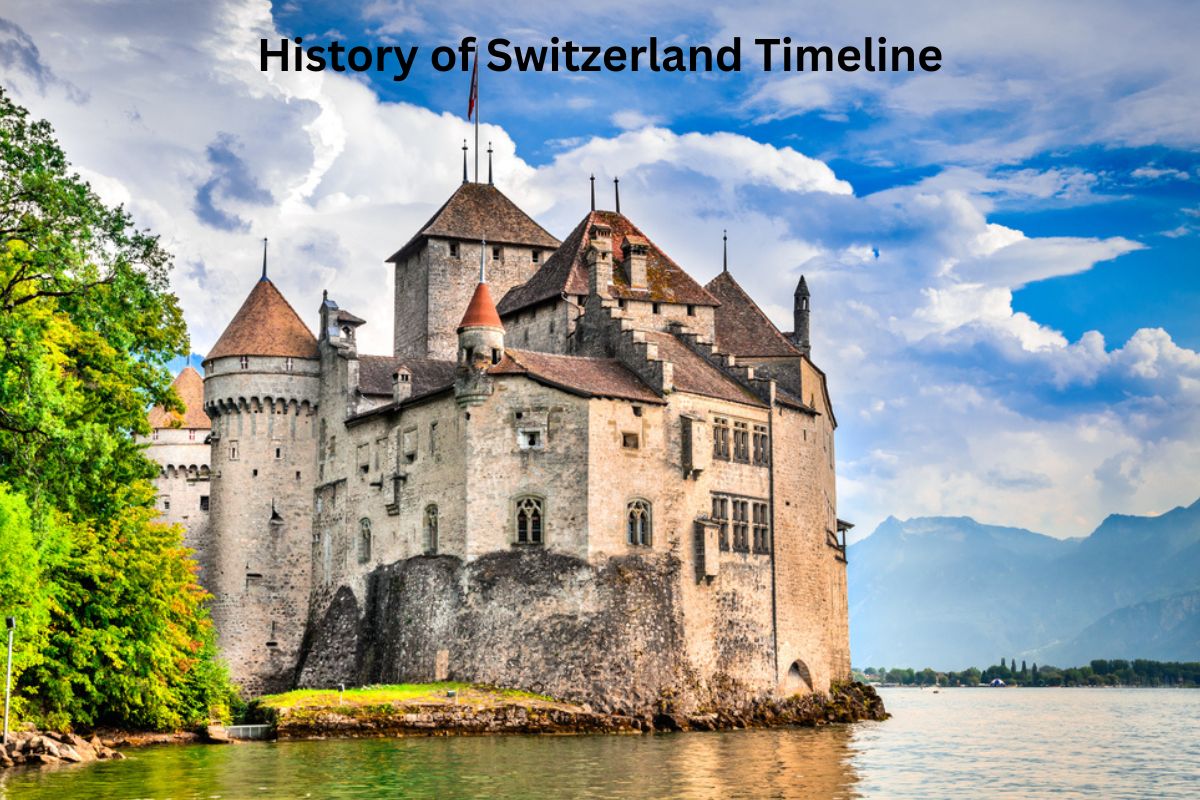The history of Switzerland is a fascinating journey marked by diversity, innovation, and neutrality. From its medieval origins as a collection of cantons united for defense, to modern times, Switzerland has navigated its unique path.
Neutrality, women’s suffrage, and decisions on European integration are pivotal moments that have shaped its story. Switzerland’s commitment to diplomacy, humanitarian efforts, and cultural diversity highlights its role on the global stage.
With a blend of languages, landscapes, and a federal structure, Switzerland’s history echoes its dedication to democracy and individual rights, forming a nation defined by its peaceful coexistence and resilience.
| Period | Key Events and Developments |
|---|---|
| Prehistoric and Roman | – 15,000 BC: Evidence of human settlements in Switzerland. |
| – 1st century BC: Roman control as part of Roman province of Raetia. | |
| Medieval Period | – 5th-6th centuries: Germanic tribes settle in the region. |
| – 1291: Signing of the Federal Charter, establishing Swiss Confederation. | |
| Early Modern Period | – 16th century: Confederation grows, internal conflicts. |
| – 1648: Peace of Westphalia recognizes Swiss independence. | |
| Napoleonic Era and Modernization | – 1798: French invasion leads to Helvetic Republic. |
| – 1815: Congress of Vienna restores Swiss independence. | |
| – 1848: Swiss Federal Constitution adopted. | |
| 20th Century | – 1907: Hague Convention recognizes Swiss neutrality. |
| – 1920: Switzerland joins League of Nations. | |
| – 1971: Women granted federal voting rights. | |
| – 1992: Referendum rejects EEA membership. | |
| Recent History | – 2002: Switzerland becomes UN member. |
| – 2004: Joins Schengen Area for border travel. | |
| – 2014: Immigration quotas referendum. | |
| – 2020: COVID-19 pandemic impacts Switzerland. |
Timeline of Swiss History
15,000 BC: Evidence of human settlements
Around 15,000 BC: Archaeological evidence suggests that hunter-gatherer groups inhabited the area that would later become Switzerland during the late Paleolithic era. These early inhabitants left behind tools, artifacts, and cave paintings.
1st century BC: Roman control begins
1st century BC: The region that is now Switzerland comes under Roman control as part of the Roman province of Raetia. The Romans established settlements, roads, and infrastructure, which contributed to the development of the area.
5th-6th centuries: Germanic tribes settle
The decline of the Western Roman Empire led to the weakening of Roman control over various territories, including the region now known as Switzerland.
Germanic tribes, such as the Alamanni and Burgundians, took advantage of the power vacuum left by the Romans’ retreat and began migrating into the area.
Also Read: History of Austria Timeline
The settlement of Germanic tribes continued, leading to the establishment of new communities and the blending of indigenous populations with the incoming groups.
The Alemanni, a prominent Germanic tribe, established their presence in the region, particularly in what is now modern-day Switzerland.
These tribes brought their own languages, cultures, and traditions, which had a lasting impact on the local societies.

1291: Federal Charter signed, Swiss Confederation established
1291: On August 1st, the three cantons of Uri, Schwyz, and Unterwalden entered into a pact known as the Federal Charter (also called the Rütlischwur) near Lake Lucerne.
This pact marked the beginning of the Swiss Confederation and was aimed at mutual defense against external threats and the maintenance of local autonomy.
Also Read: Italian History Timeline
14th to 15th centuries: The Swiss Confederation expanded as more cantons joined, including Zurich, Lucerne, Zug, Bern, and others. The Confederation formed as a loose alliance of semi-autonomous regions, each with its own government and laws, but united by common interests such as defense and trade.
1648: Peace of Westphalia recognizes Swiss independence
1648: The Peace of Westphalia, which ended the Thirty Years’ War in Europe, recognized Switzerland’s independence and neutrality. This recognition solidified Switzerland’s status as a sovereign nation and established its longstanding policy of neutrality in conflicts.

1798: French invasion leads to Helvetic Republic
Late 18th century: During the French Revolutionary Wars, French troops under Napoleon Bonaparte invaded Switzerland in 1798.
This led to the dissolution of the Old Swiss Confederation and the establishment of the Helvetic Republic, a centralized government heavily influenced by French revolutionary ideals.
1815: Congress of Vienna restores Swiss independence
1815: The Congress of Vienna, after Napoleon’s defeat, recognized Switzerland’s neutrality and independence. The country’s borders were reaffirmed, and the Swiss Confederation was reestablished.
The Congress also granted Switzerland certain territories that had previously been under other powers’ control.
1848: Swiss Federal Constitution adopted
1848: A period of political and social reform led to the adoption of the Swiss Federal Constitution.
This constitution transformed Switzerland from a loose confederation of semi-autonomous cantons into a federal state with a centralized government while still respecting the cantonal autonomy.
1907: Hague Convention recognizes Swiss neutrality
1907: Switzerland hosted the second Hague Peace Conference, which led to the adoption of international treaties, including the recognition of Switzerland’s permanent neutrality in times of armed conflict. This further solidified Switzerland’s role as a neutral intermediary in international diplomacy.
1920: Switzerland joins League of Nations
The League of Nations was established in 1920 as an international organization aimed at maintaining peace and preventing conflicts after the devastation of World War I.
Switzerland, known for its longstanding neutrality and its tradition of mediation, decided to join the League of Nations as a way to further contribute to international diplomacy and peacekeeping efforts.
Switzerland’s membership in the League of Nations allowed it to participate in discussions, negotiations, and decisions concerning international disputes and the promotion of collective security.
1992: Referendum rejects EEA membership
In 1992, Switzerland held a pivotal referendum in which the country rejected membership in the European Economic Area (EEA). This event had significant implications for Switzerland’s relationship with the European Union (EU) and its approach to European integration.
The referendum resulted in a narrow rejection of EEA membership, with 50.3% of Swiss voters voting against joining the EEA and 49.7% voting in favor.
The rejection of EEA membership was a turning point in Switzerland’s relationship with the EU. It led to a more cautious and piecemeal approach to European integration.
Instead of joining the EEA, Switzerland pursued a series of bilateral agreements with the EU, addressing specific areas of cooperation such as trade, transportation, and research.
2002: Switzerland becomes UN member
Throughout the 20th century: Switzerland continued to evolve politically and socially. Women gained the right to vote at the federal level in 1971, and the country focused on human rights and international cooperation.
Switzerland joined the United Nations in 2002 and became a member of the Schengen Area in 2004.
2004: Joins Schengen Area for border travel
2004: Switzerland became a member of the Schengen Area, a zone that allows for passport-free travel and the removal of border controls between participating European countries.
This move facilitated easier movement across borders and strengthened Switzerland’s integration into the European community.
2014: Immigration quotas referendum
2014: Switzerland held a referendum on immigration quotas, which aimed to limit the number of immigrants from European Union countries. The referendum sparked debate about immigration policies, economic implications, and Switzerland’s relationship with the EU.
2020: COVID-19 pandemic impacts Switzerland
2020: Like much of the world, Switzerland was affected by the COVID-19 pandemic. The country implemented measures such as lockdowns, travel restrictions, and vaccination campaigns to mitigate the spread of the virus and protect public health. The pandemic also had economic and social consequences.
Ongoing Political and Economic Developments:
In recent years, Switzerland has continued to navigate political and economic challenges, including discussions about its relationship with the European Union, trade agreements, and economic policies. The country’s unique position as a neutral nation and its strong banking and finance sectors contribute to its ongoing role on the global stage.
